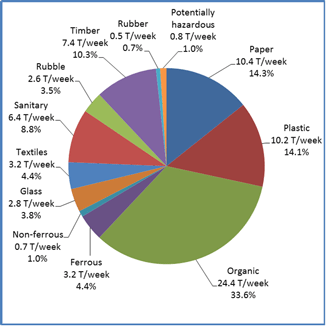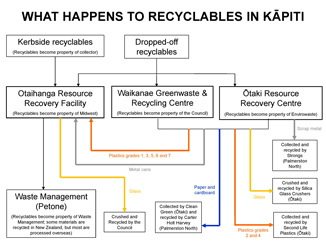“There’s no such thing as waste, only the wrong thing in the wrong place at the wrong time”, says Simon Calcinai, KCDC’s Waste Minimisation Officer.
Poorer countries such as India and China far exceed the recycling efforts of westernised nations like New Zealand, he told Transition Town Ōtaki members at a recent meeting. Waste streams are virtual gold-mines to those living in extreme poverty and the result is an almost 100% recycling rate.
The annual 20,000-odd tonnes of waste that leaves Kāpiti, mostly to Levin’s Hokio Beach landfill, is the result of the poor planning and design which underpins our consumption-based lifestyle.
“Ships come from China full of tat for us to buy and we send them back full of material to be recycled,” said Simon, who advocates permaculture and its key design principle of “no waste”.
Apart from what ends up at the council-owned Waikanae green waste and recycling centre, virtually all the waste and recycling that we generate becomes privately owned when picked up at the kerb and taken to either of the Ōtaki or Otaihanga transfer stations.
The big waste companies (three operate in Kāpiti) currently make most of their money from burying waste, not recycling. Apart from some scrap metal and clearly useable objects, our rubbish goes more or less as is to the landfill at Hokio. When waste services were council-owned, there was a greater emphasis on waste diversion, as is still seen in the few areas of New Zealand where public ownership continues.
What’s in the bin?
A staggering 24.4 tonnes of organic waste a week goes out of Ōtaki alone, 130 tonnes out of the whole of Kāpiti. This is a third of our total waste and about half is food waste, the other half compostable green waste. Simon estimates that a typical kiwi household spends around $1000 per year on wasted food that could have been eaten. Supermarkets also generate huge amounts of perfectly edible food waste, close to or just past its use-by date.
We’re also big dumpers of plastic and paper, at about 14% each of the Ōtaki waste stream, much of which could have been recycled. Timber is about 10%, most of it chemically treated, so unsuitable for firewood. The “sanitary” category, including disposable nappies, makes close to 9% of our waste. Altogether we could be saving ourselves around $2000 a year if we stopped wasting food, composted, recycled and cut down on packaging and disposables.
Where there’s muck there’s brass
The Kāpiti waste system, apart from the Waikanae station, is entirely user-pays. The council grants licences to commercial operators, who must provide kerbside recycling to their urban customers as part of the arrangement. Our rubbish goes to the Hokio landfill not because of any not-in-my-backyard stance but because the leaseholders of the two transfer stations, Envirowaste at Ōtaki and Midwest at Otaihanga presumably find that is the most economic option.
As long as recyclable materials are not contaminated there are now markets for almost everything, most of them overseas.
Some paper and cardboard are recycled in NZ, used for pulp for new products by Carter Holt Harvey. Steel is recast in Auckland to make beams and girders, while aluminium goes to Australia to be melted down for new cans.
Second Life plastics in Ōtaki recycle some grades of plastic, while Silica Glass Crushers is another local firm successfully recycling glass right on our doorstep.
E-waste is the fastest growing waste stream and, apart from cell-phones, the cost of recycling often exceeds the return. Mary Potter Hospice shop next to Mobil in Paraparaumu currently takes most forms of e-waste free and recycles them through Wellington firms. The Council is working with operators to expand the variety of e-waste recycling options available at transfer stations.
Many of the commonly used, disposable batteries in AA and AAA sizes can be safely disposed of in the land-fill, but if in doubt, take them to Ōtaki transfer station to be recycled or safely disposed, says Simon Calcinai.
For further information see the KCDC website: www.kapiticoast.govt.nz/waste

